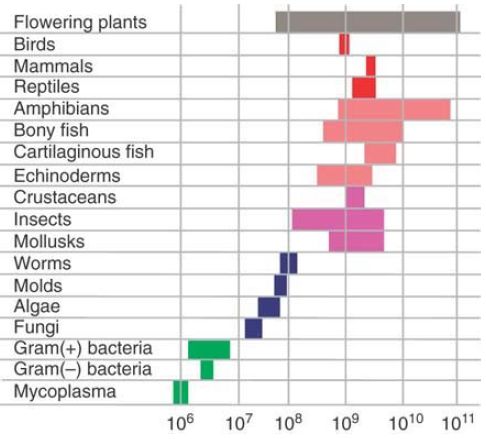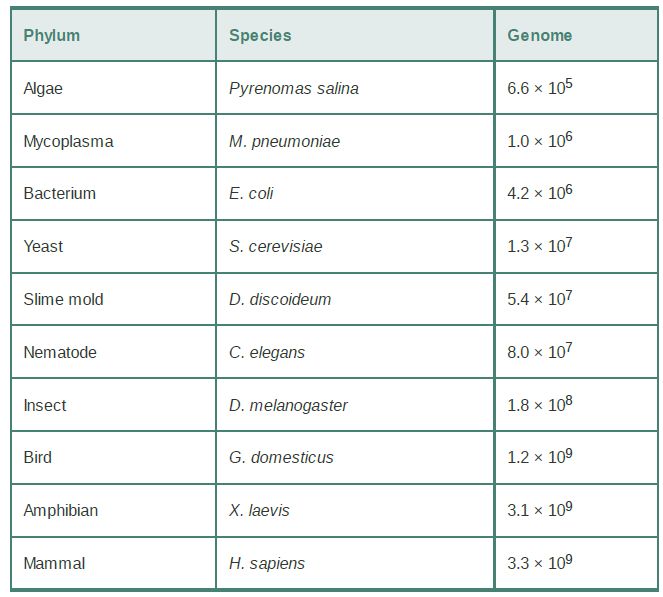


 النبات
النبات
 الحيوان
الحيوان
 الأحياء المجهرية
الأحياء المجهرية
 علم الأمراض
علم الأمراض
 التقانة الإحيائية
التقانة الإحيائية
 التقنية الحيوية المكروبية
التقنية الحيوية المكروبية
 التقنية الحياتية النانوية
التقنية الحياتية النانوية
 علم الأجنة
علم الأجنة
 الأحياء الجزيئي
الأحياء الجزيئي
 علم وظائف الأعضاء
علم وظائف الأعضاء
 الغدد
الغدد
 المضادات الحيوية
المضادات الحيوية|
Read More
Date: 3-6-2021
Date: 3-12-2015
Date: 9-11-2020
|
Why Are Some Genomes So Large?
KEY CONCEPTS
-There is no clear correlation between genome size and genetic complexity.
-There is an increase in the minimum genome size associated with organisms of increasing complexity.
-There are wide variations in the genome sizes of organisms within many taxonomic groups.
The total amount of DNA in the (haploid) genome is a characteristic of each living species known as its C-value. There is enormous variation in the range of C-values, from less than 106 base pairs (bp) for a mycoplasma to more than 1011 bp for some plants and amphibians.
FIGURE 1. summarizes the range of C-values found in different taxonomic groups. There is an increase in the minimum genome size found in each group as the complexity increases. Although Cvalues are greater in the multicellular eukaryotes, we do see some wide variations in the genome sizes within some groups.

FIGURE 1. DNA content of the haploid genome increases with morphological complexity of lower eukaryotes, but varies extensively within some groups of animals and plants. The range of DNA values within each group is indicated by the shaded area.
Plotting the minimum amount of DNA required for a member of each group suggests in FIGURE 2. that an increase in genome size is required for increased complexity in prokaryotes, fungi, and invertebrate animals.

FIGURE 2. The minimum genome size found in each taxonomic group increases from prokaryotes to mammals.
Mycoplasma are the smallest prokaryotes and have genomes only about three times the size of a large bacteriophage and smaller than those of some megaviruses. More typical bacterial genome sizes start at about 2 × 106 bp. Unicellular eukaryotes (whose lifestyles can resemble those of prokaryotes) also get by with genomes that are small, although their genomes are larger than those of most bacteria. However, being eukaryotic does not imply a vast increase in genome size, per se; a yeast can have a genome size of about 1.3 × 107 bp, which is only about twice the size of an average bacterial genome.
A further twofold increase in genome size is adequate to support the slime mold Dictyostelium discoideum, which is able to live in either unicellular or multicellular modes. Another increase in complexity is necessary to produce the first fully multicellular organisms; the nematode worm C. elegans has a DNA content of 8 × 107 bp.
We also can see the steady increase in genome size with complexity in the listing in TABLE 1. of some of the most commonly studied organisms. It is necessary for insects, birds, amphibians, and mammals to have larger genomes than those of unicellular eukaryotes. However, after this point there is no clear relationship between genome size and morphological complexity of the organism.
TABLE 1. The genome sizes of some commonly studied organisms.

We know that eukaryotic genes are much larger than the sequences needed to encode polypeptides because exons might comprise only a small part of the total length of a gene. This
explains why there is much more DNA than is needed to provide reading frames for all the proteins of the organism. Large parts of an interrupted gene might not encode amino acids. In addition, in multicellular organisms there can be significant lengths of DNA between genes, some of which function in gene regulation. So it might not be possible to deduce anything about the number of genes or the complexity of the organism from the overall size of the genome.
The C-value paradox refers to the lack of correlation between genome size and genetic and morphological complexity (e.g., the number of different cell types). There are some extremely curious observations about relative genome size, such as that the toad Xenopus and humans have genomes of essentially the same size.
In some taxonomic groups there are large variations in DNA content between organisms that do not vary much in complexity. (This is especially marked in insects, amphibians, and plants, but does not occur in birds, reptiles, and mammals, which all show little variation within the group—an approximately 23-fold range of genome sizes.) A cricket has a genome 11 times the size of that of a fruit fly. In amphibians, the smallest genomes are less than 109 bp, whereas the largest are about 1011 bp. There is unlikely to be a large difference in the number of genes needed for the development of these amphibians. Some fish species have about the same number of genes as mammals have, but other fish genomes (such as that of the pufferfish fugu) are more compact, with smaller introns and shorter intergenic spaces. Still others are tetraploid. The extent to which this variation is selectively neutral or subject to natural selection is not yet fully understood.
In mammals, additional complexity is also a consequence of the alternative splicing of genes that allows two or more protein variants to be produced from the same gene .



|
|
|
|
اكتشاف تأثير صحي مزدوج لتلوث الهواء على البالغين في منتصف العمر
|
|
|
|
|
|
|
زهور برية شائعة لتر ميم الأعصاب التالفة
|
|
|
|
|
|
قسم التطوير يناقش بحوث الدفعة الأولى من طلبة أكاديمية التطوير الإداري
|
|
|
|
جناح جمعية العميد في معرض تونس للكتاب يتحوّل إلى نافذةٍ للتعرّف على العراق
|
|
|
|
وفد ديوان الوقف الشيعي يطّلع على نسب إنجاز مستشفى الزكيّ في بابل
|
|
|
|
إدارة معرض النجف الدولي: العتبة العباسية أثبتت دعمها للمنتج المحلي برفعها شعار (صنع في العراق)
|